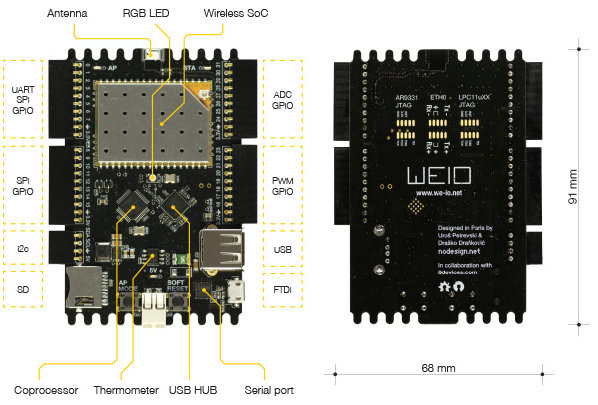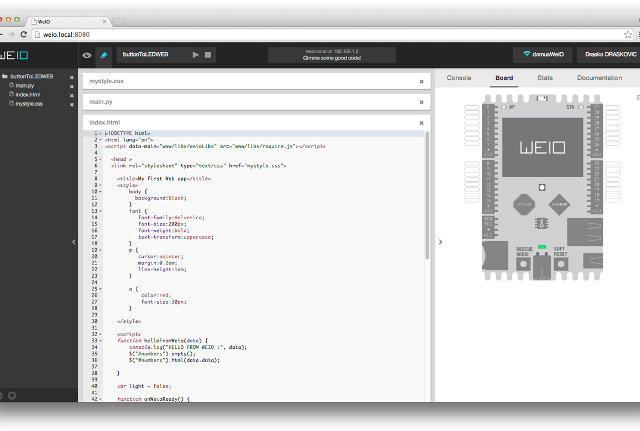WeIO is an open source hardware board for the Internet of things with Wi-Fi connectivity and lots of I/Os designed by nodesign, a French based startup, in collaboration of 8devices, the makers of the Carambola boards. WeIO is powered by an Atheros AR9331 SoC running OpenWRT as well as an NXP LPC MCU for faster handling of I/Os and support for analog I/Os. One interesting aspect of this board is that it can be programmed via a web browser using HTML5 or Python, and it does not rely on the Cloud to store data.

WeIO hardware specifications:
- SoC – Atheros AR9331 MIPS 24K Wireless SoC @ 400 MHz
- MCU – NXP LPC11xx ARM Cortex M0 MCU for analog I/O and real-time H/W interfaces
- System Memory – 64 MB DDR2
- Storage – 16 MB flash + micro SD slot
- Connectivity – 802.11 b/g/n Wi-Fi with on-board antenna (AP and STA modes), solder pads for Ethernet
- USB – 1x USB 2.0 host port (for storage, webcam, sound cards, …), 1x micro USB (FTDI) for console access.
- Expansion Headers – 5 headers with:
- 32x GPIO
- 1x UART, 2x SPI, 1x I2C
- 8x ADC with 10-bit precision
- 6x PWM with 16-bit precision
- Debugging – micro USB for programming, JTAG solder pads for AR9331 SoC, and LPC11xx MCU.
- Misc – RGB LED connected to 3 PWM outputs, AP mode and soft reset buttons, LM75 digital thermometer
- Power – 3.3V operating voltage, 5V tolerant I/Os (except ADC), external supply 5V.
- Dimensions – 91 x 68 mm
There’s no IDE to install to program WeIO, as everything can be done from WeIO IDE hosted on the board itself, and you just need to connect using your favorite Web browser. There’s no cross-compiling, board flashing, or programming electronics in C, unless you plan to update OpenWRT or the MCU firmware. That also means you should be able to program the board from any operating system, be it Windows, Linux, Mac OS, or even Android, FreeBSD…

The API is said to be “Arduino-like”, but using HTML5 (HTML, Javascript, CSS) and/or Python. You can find related code on weio repository on github.Some of the server technologies or protocols used include Tornado web server (written in Python), Websockets, SSH and SMB, and Bonjour zeroconf. The board is also supposed to be open source hardware, but the hardware design files do not appear to have been released just yet.
The company has made some demos using WeIO such as a smart lamp, real-time data visualizaton on iOS or Android smartphones, various displays support, music and video streaming, interfacing with Arduino, and so on. You can watch the video for an overview of the board and have a look at some of the demos.
The project has been launched on Indiegogo, and have already reached its $10,000 funding target. A $86 pledge will get you a WeIO board, but various kits are available between $99 to $399, and there are also 1 to 2-day workshops for several thousands dollars. Shipping is either free, or $9 to Europe, and $12 to the other continents, depending on the perks, and delivery is scheduled for November 2014. You may also want to visit we-io.net for access to full documentation (work in progress), and/or join WeIO Google+ Community.

Jean-Luc started CNX Software in 2010 as a part-time endeavor, before quitting his job as a software engineering manager, and starting to write daily news, and reviews full time later in 2011.
Support CNX Software! Donate via cryptocurrencies, become a Patron on Patreon, or purchase goods on Amazon or Aliexpress




